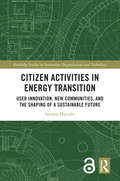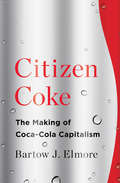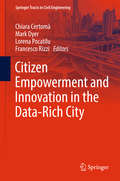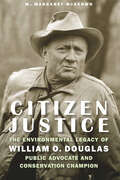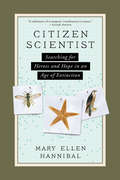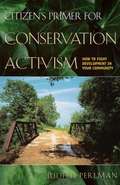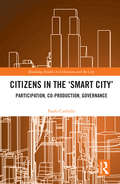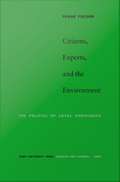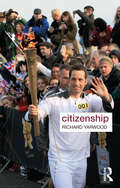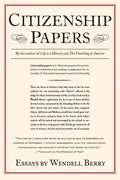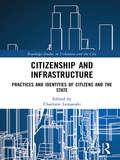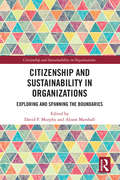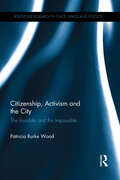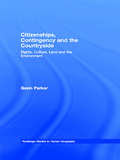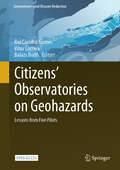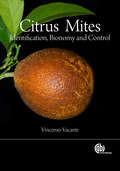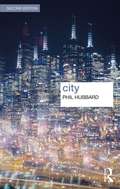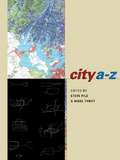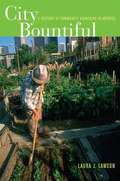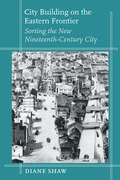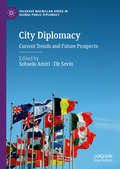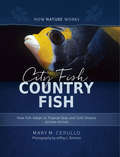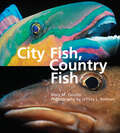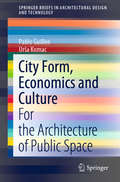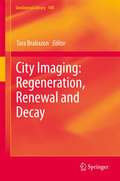- Table View
- List View
Citizen Activities in Energy Transition: User Innovation, New Communities, and the Shaping of a Sustainable Future (Routledge Studies in Innovation, Organizations and Technology)
by Sampsa HyysaloThis book addresses the rapidly changing citizen roles in innovation, technology adoption, intermediation, market creation, and legitimacy building for low-carbon solutions. It links research in innovation studies, sustainability transitions, and science and technology studies, and builds a new approach for the study of user contributions to innovation and sociotechnical change. Citizen Activities in Energy Transition gives detailed and empirically grounded overall appraisal of citizens’ active technological engagement in the current energy transition, in an era when Internet connectivity has given rise to important new forms of citizen communities and interactions. It elaborates a new way to study users in sociotechnical change through long-term ethnographic and historical research and reports its deployment in a major, decade-long line of investigation on user activities in small-scale renewables, addressing user contributions from the early years to the late proliferation stages of small-scale renewable energy technologies (S-RETs). It offers a much-needed empirical and theoretical understanding of the dynamics of the activities in which users are engaged over the course of sociotechnical change, including innovation, adoption, adjustment, intermediation, community building, digital communities, market creation, and legitimacy creation. This work is a must-read for those seeking to understand the role of users in innovation, energy systems change and the significance of new digital communities in present and future sociotechnical change. Academics, policymakers, and managers are given a new resource to understand the "demand side" of sociotechnical change beyond the patterns of investment, adoption, and social acceptance that have traditionally occupied their attention.
Citizen Coke: The Making of Coca-Cola Capitalism
by Bartow J. ElmoreAn absorbing history of how Coke's insatiable thirst for natural resources shaped the company and reshaped the globe. How did Coca-Cola build a global empire by selling a low-price concoction of mostly sugar, water, and caffeine? The easy answer is advertising, but the real formula to Coke's success was its strategy, from the start, to offload costs and risks onto suppliers, franchisees, and the government. For most of its history the company owned no bottling plants, water sources, cane- or cornfields. A lean operation, it benefited from public goods like cheap municipal water and curbside recycling programs. Its huge appetite for ingredients gave it outsized influence on suppliers and congressional committees. This was Coca-Cola capitalism. In this new history Bartow J. Elmore explores Coke through its ingredients, showing how the company secured massive quantities of coca leaf, caffeine, sugar, and other inputs. Its growth was driven by shrewd leaders such as Asa Candler, who scaled an Atlanta soda-fountain operation into a national empire, and "boss" Robert Woodruff, who nurtured partnerships with companies like Hershey and Monsanto. These men, and the company they helped build, were seen as responsible citizens, bringing jobs and development to every corner of the globe. But as Elmore shows, Coke was usually getting the sweet end of the deal. It continues to do so. Alongside Coke's recent public investments in water purification infrastructure, especially in Africa, it has also built--less publicly--a rash of bottling plants in dangerously arid regions. Looking past its message of corporate citizenship, Elmore finds a strategy of relentless growth. The costs shed by Coke have fallen on the public at large. Its annual use of many billions of gallons of water has strained an increasingly scarce global resource. Its copious servings of high-fructose corn syrup have threatened public health. Citizen Coke became a giant in a world of abundance. In a world of scarcity it is a strain on resources and all who depend on them.
Citizen Empowerment and Innovation in the Data-Rich City (Springer Tracts in Civil Engineering)
by Chiara Certomà Mark Dyer Lorena Pocatilu Francesco RizziThis book analyzes the ongoing transformation in the "smart city" paradigm and explores the possibilities that technological innovations offer for the effective involvement of ordinary citizens in collective knowledge production and decision-making processes within the context of urban planning and management. To so, it pursues an interdisciplinary approach, with contributions from a range of experts including city managers, public policy makers, Information and Communication Technology (ICT) specialists, and researchers. The first two parts of the book focus on the generation and use of data by citizens, with or without institutional support, and the professional management of data in city governance, highlighting the social connectivity and livability aspects essential to vibrant and healthy urban environments. In turn, the third part presents inspiring case studies that illustrate how data-driven solutions can empower people and improve urban environments, including enhanced sustainability. The book will appeal to all those who are interested in the required transformation in the planning, management, and operations of data-rich cities and the ways in which such cities can employ the latest technologies to use data efficiently, promoting data access, data sharing, and interoperability.
Citizen Justice: The Environmental Legacy of William O. Douglas—Public Advocate and Conservation Champion
by Hon. M. Margaret McKeownU.S. Supreme Court Justice William O. Douglas was a giant in the legal world, even if he is often remembered for his four wives, as a potential vice-presidential nominee, as a target of impeachment proceedings, and for his tenure as the longest-serving justice from 1939 to 1975. His most enduring legacy, however, is perhaps his advocacy for the environment. Douglas was the spiritual heir to early twentieth-century conservation pioneers such as Teddy Roosevelt and John Muir. His personal spiritual mantra embraced nature as a place of solitude, sanctuary, and refuge. Caught in the giant expansion of America&’s urban and transportation infrastructure after World War II, Douglas became a powerful leader in forging the ambitious goals of today&’s environmental movement. And, in doing so, Douglas became a true citizen justice. In a way unthinkable today, Douglas ran a one-man lobby shop from his chambers at the U.S. Supreme Court, bringing him admiration from allies in conservation groups but raising ethical issues with his colleagues. He became a national figure through his books, articles, and speeches warning against environmental dangers. Douglas organized protest hikes to leverage his position as a national icon, he lobbied politicians and policymakers privately about everything from logging to highway construction and pollution, and he protested at the Supreme Court through his voluminous and passionate dissents. Douglas made a lasting contribution to both the physical environment and environmental law—with trees still standing, dams unbuilt, and beaches protected as a result of his work. His merged roles as citizen advocate and justice also put him squarely in the center of ethical dilemmas that he never fully resolved. Citizen Justice elucidates the why and how of these tensions and their contemporary lessons against the backdrop of Douglas&’s unparalleled commitment to the environment.
Citizen Scientist: Searching for Heroes and Hope in an Age of Extinction
by Mary Ellen HannibalA San Francisco Chronicle Best Book of the Year: “Intelligent and impassioned, Citizen Scientist is essential reading for anyone interested in the natural world.”A Nautilus Award Winner in Ecology and EnvironmentAward-winning writer Mary Ellen Hannibal has long reported on scientists’ efforts to protect vanishing species. But it was only through citizen science that she found she could take action herself. As she wades into tide pools, spots hawks, and scours mountains, she discovers the power of the heroic volunteers who are helping scientists measure—and even slow—today’s unprecedented mass extinction. Citizen science may be the future of large-scale field research—and “might be our last, best hope for solving myriad environmental predicaments” (Library Journal).our planet’s last, best hope.“Inspired by the likes of marine biologist Ed Ricketts, [Hannibal] records starfish die-offs, meets the geeks who track deforestation, and plans a web-based supercommunity of citizen scientists to counter what many are calling the sixth great extinction. A cogent call to action.” —Nature“Hannibal’s use of details verges on the sublime.” —East Hampton Star“[A] celebration of nonexperts’ contributions to science.” —Scientific American
Citizen's Primer for Conservation Activism: How to Fight Development in Your Community
by Judith PerlmanIs there anything you can do when development threatens your local forest, beach, prairie, or wetland? Yes, there is. Across America, citizen activists are fighting and winning battles against unwanted development in their own communities. To help you resist the urban sprawl and absentee landowners that can wreck small towns and cities alike, this book is a practical, hands-on guide for building a grassroots campaign to defeat undesirable development. Written by a successful activist, Citizen's Primer for Conservation Activism takes you through all the steps necessary to stop unplanned development in your community:- Identifying the issues at stake- Getting involved and developing leadership- Devising a strategy- Hiring and working with legal counsel- Building coalitions and partnerships- Influencing local government- Conducting a media campaign- Raising money- Countering developer tactics- Managing the whole processWith the proven strategies in this easy-to-access book, you can quickly gear up to challenge unwanted development and preserve the character of your local community.
Citizens in the 'Smart City': Participation, Co-production, Governance (Routledge Studies in Urbanism and the City)
by Paolo CardulloThis book critically examines ‘smart city’ discourse in terms of governance initiatives, citizen participation, and policies which place emphasis on the ‘citizen’ as an active recipient and co-producer of technological solutions to urban problems. The current hype around ‘smart cities’ and digital technologies has sparked debates in the fields of citizenship, urban studies, and planning surrounding the rights and ethics of participation. It has also sparked debates around the forms of governance these technologies actively foster. This book presents new sociotechnological systems of governance that monitor citizen power, trust-building strategies, and social capital. It calls for new data economics and digital rights for a city founded on normative ideals rather than neoliberal ones. It adopts a prescriptive approach, arguing that a ‘reloaded’ smart city should foster citizenship as a new set of civil and social rights and the ‘citizen’ as a subject vested with active and meaningful forms of participation and political power. Ultimately, the book questions the utility of the ‘smart city’ project for radical municipalism, proposing a technological enough but more democratic city – an ‘intelligent city’, in fact. Offering useful contributions to ‘smart city’ initiatives for the protection of emerging digital citizenship rights and socially accrued benefits, this book will draw the interest of researchers, policymakers, and professionals in the fields of urban studies, urban planning, urban geography, computing and technology studies, urban politics, and urban economics.
Citizens, Experts, and the Environment: The Politics of Local Knowledge
by Frank FischerThe tension between professional expertise and democratic governance has become increasingly significant in Western politics. Environmental politics in particular is a hotbed for citizens who actively challenge the imposition of expert theories that ignore forms of local knowledge that can help to relate technical facts to social values. Where information ideologues see the modern increase in information as capable of making everyone smarter, others see the emergence of a society divided between those with and those without knowledge. Suggesting realistic strategies to bridge this divide, Fischer calls for meaningful nonexpert involvement in policymaking and shows how the deliberations of ordinary citizens can help solve complex social and environmental problems by contributing local contextual knowledge to the professionals' expertise. While incorporating theoretical critiques of positivism and methodology, he also offers hard evidence to demonstrate that the ordinary citizen is capable of a great deal more participation than is generally recognized. Popular epidemiology in the United States, the Danish consensus conference, and participatory resource mapping in India serve as examples of the type of inquiry he proposes, showing how the local knowledge of citizens is invaluable to policy formation. In his conclusion Fischer examines the implications of the approach for participatory democracy and the democratization of contemporary deliberative structures. This study will interest political scientists, public policy practitioners, sociologists, scientists, environmentalists, political activists, urban planners, and public administrators along with those interested in understanding the relationship between democracy and science in a modern technological society.
Citizenship (Key Ideas in Geography)
by Richard YarwoodThe idea of citizenship is widely used in daily life. ‘Citizenship tests’ are used to determine who can inhabit a country; ‘citizen charters’ have been used to prescribe levels of service provision; ‘citizens’ juries’ are used in planning or policy enquiries; ‘citizenship’ lessons are taught in schools; youth organisations attempt often aim to instil ‘good’ citizenship; ‘active citizens’ are encouraged to contribute voluntary effort to their local communities and campaigners may use ‘citizens’ rights’ to achieve their goals. What is meant by citizenship is never static and the subject of debate by academics, politicians and activists. These ideas are manifest and contested at a range of different scales. This book therefore argues geography is crucial to understanding citizenship. The text is organised around a number of spatial themes to examine how spatialities of citizenship are played out at a range of scales. Ideas about locality, boundaries, mobility, networks, rurality and globalisation are used to reveal the importance of space and place in the constitution, contestation and performance of citizenship. In doing so, the book reveals how different ideas of citizenship can include or exclude people from society and space. Consideration is given to ways in which different groups have sought to empower themselves through various actions associated with and beyond conventional notions of citizenship. Written in an accessible way with detailed case studies to illustrate conceptual ideas and approaches, this book offers social scientists new spatial perspectives on citizenship while also bridging together strands of social, cultural and political geography in ways that deepen understandings of people and place.
Citizenship Papers
by Wendell Berry"Citizenship Papers" collects 21 new essays, from celebrations of exemplary lives to critiques of American life, including "A Citizen's Response to the New National Security Strategy" -- a ringing call of caution to a nation standing on the brink of global catastrophe.
Citizenship and Infrastructure: Practices and Identities of Citizens and the State (Routledge Studies in Urbanism and the City)
by Charlotte LemanskiThis book brings together insights from leading urban scholars and explicitly develops the connections between infrastructure and citizenship. It demonstrates the ways in which adopting an ‘infrastructural citizenship’ lens illuminates a broader understanding of the material and civic nature of urban life for both citizens and the state. Drawing on examples of housing, water, electricity and sanitation across Africa and Asia, chapters reveal the ways in which exploring citizenship through an infrastructural lens, and infrastructure through a citizenship lens, allows us to better understand, plan and govern city life. The book emphasises the importance of acknowledging and understanding the dialectic relationship between infrastructure and citizenship for urban theory and practice. This book will be a useful resource for researchers and students within Urban Studies, Geography, Development Studies, Planning, Politics, Architecture and Sociology.
Citizenship and Sustainability in Organizations: Exploring and Spanning the Boundaries (Citizenship and Sustainability in Organizations)
by David F. Murphy; Alison MarshallCitizenship and Sustainability in Organizations: Exploring and Spanning the Boundaries is the introductory book in the series of the same name and draws upon new conceptual thinking from some of the leading contributors to The Journal of Corporate Citizenship on topics of social responsibility, organizational citizenship, influencing and leading change for sustainability and individual agency. Chapter authors are influential thinkers, pushing the boundaries of conventional thinking about corporate citizenship and sustainability to generate inovative ideas, models and practices. The book’s core message is that the contexts within which organizations and individuals act are undergoing significant change and disruption. Existing corporate social responsibility (CSR), corporate citizenship and business sustainability models and frameworks need to be adapted, abandoned or transformed. This book represents a starting point for dialogue about these challenges and presents commentaries, debates, essays and insights that aim to be provocative and engaging, raise some of the important issues of the day and provide observations on what may be too new yet to be the subject of detailed empirical and theoretical studies. The book is aimed at researchers, students and practitioners in the fields of corporate citizenship, sustainability, CSR, business ethics, corporate governance and critical management and leadership studies.
Citizenship, Activism and the City: The Invisible and the Impossible (Routledge Research in Place, Space and Politics)
by Patricia Burke WoodWere the occupations of 2010–11 – from Spain to Tahrir Square to Occupy Wall Street – a success or failure? Are they the model for urban radical politics? This book challenges common understandings and underlying assumptions of what constitutes activism and resistance. It proposes a critical urban theory of politics and citizenship that is grounded in the city as it is inhabited. For those who are marginalized, the city is a double-edged sword of oppression and emancipation. This book argues for an intersectional approach that actively dismantles hierarchies and embraces a wider range of acts of resistance and creative transformation, one in which we recognize these acts of citizenship as a form of constitutionalism. Wood reframes the theorization of protest and of the city, 'post-political' literature and the history of protest, and Marxist and anarchist ideas about the time and space of politics. Through this, she adopts a unique approach to provide new theoretical insights and challenges to post-political thinking. This book will be valuable reading for those interested in political, urban and social geography, in addition to political economy and progressive politics in the urban context.
Citizenships, Contingency and the Countryside: Rights, Culture, Land and the Environment (Routledge Studies in Human Geography #Vol. 2)
by Gavin ParkerCitizenships, Contingency and the Countryside defines citizenship in relation to the rural environment. The book expands and explores a widened conceptualization of citizenship and sets out a range of examples where citizenship, at different scales, has been expressed in and over the rural environment. Part of the analysis includes a review of the political construction and use of citizenship rhetoric over the past 20 years, alongside an historical and theoretical discussion of citizenship and rights in the British countryside. The text concludes with a call to recognise and incorporate the multiple voices and interests in decision-making, that all affect the British countryside.
Citizens’ Observatories on Geohazards: Lessons from Five Pilots (Geoenvironmental Disaster Reduction)
by Rui Carrilho Gomes Vítor Correia Balazs BodóThis open access book shows how citizens' involvement in geohazard risks prevention can strengthen regional and national risk management systems, to demonstrate a new form of engagement between civil society and local authorities. The lessons learned in in this book, where the local communities were engaged to actively participate in risk preparedness and monitoring and incorporate local capacities into risk management systems, are reported. A cooperation and resource platform on geohazards risk assessment, preparedness, mitigation, and prevention was used as interface between the citizens and the risk management system. A more efficient uptake of Copernicus data, products, and services on regional level is discussed, to improve geohazard risk prevention and resilience to natural disasters. Recommendations for the creation of future observatories in response to the widest range of hazards (both natural and human-induced) in Europe and in the world are provided.
Citrus Mites: Identification, Bionomy and Control
by Vincenzo VacanteCitrus pests are a serious issue for crop growers, causing problems in yield and economic losses. Citrus Mites is a comprehensive study of mites harmful to citrus plants from all citrus growing regions around the world. Providing a useful resource for identifying citrus crop pests, the text will also address methods of removal from plants, describe symptoms of damage caused by pests and discuss methods of eradication and control, making it essential for horticulturalists, pomologists and acarologists as well as practitioners, researchers and students of crop protection and pest management.
City (Key Ideas in Geography)
by Phil HubbardCity provides an accessible yet critical introduction to one of the key ideas in human geography. While most of the world’s population now lives in cities, the definition and theoretical specification of the city nonetheless remains elusive. In this extensively updated second edition, Phil Hubbard considers the different ways that the lived and messy realities of urban life have been approached by geographers, past and present. Situating these in the context of ongoing debates concerning globalization, urban fragmentation and planetary urbanism, this new edition considers how contemporary understandings of cities are being enriched via engagement with feminist, queer and post-colonial perspectives. Drawing on a diverse range of literature and case studies from around the world, and featuring boxed explorations of key concepts, City is an essential guide to urban geography for the experienced researcher and novice alike.
City A-Z: Urban Fragments
by Nigel Thrift Steve PileFeaturing a fantastic line up of contributors, The City A-Z introduces students to a refreshingly new way of thinking about and understanding cities and urban life. Specially comissioned short entries capture moments of the city, constantly surprising the reader with entries ranging from poetry to prose, from paintings to a photo-essay, and from rigorous noisy analysis to quiet stories of city life. An "ideas" map, similar to the London Underground map, links all the different themes providing a route through this unique text.Includes contributions from: Ash Amin , Anette Baldauf , David Bell, Walter Benjamin, Alistair Bonnett, Iain Borden, Stephen Cairns, Iain Chambers, Steve Graham, Dolores Hayden, Steve Hinchcliffe, Mary King, Deborah Levy, Eugene McLoughlin, Harvey Molotch, Miles Ogborn, Steve Pile, Roy Porter, Jane Rendell, Saskia Sassen, David Sibley, Sharon Zukin
City Bountiful: A Century of Community Gardening in America
by Laura J. LawsonSince the 1890s, providing places for people to garden has been an inventive strategy to improve American urban conditions. There have been vacant-lot gardens, school gardens, Depression-era relief gardens, victory gardens, and community gardens―each representing a consistent impulse to return to gardening during times of social and economic change. In this critical history of community gardening in America, the most comprehensive review of the greening of urban communities to date, Laura J. Lawson documents the evolution of urban garden programs in the United States. Her vibrant narrative focuses on the values associated with gardening, the ebb and flow of campaigns during times of social and economic crisis, organizational strategies of these primarily volunteer campaigns, and the sustainability of current programs.
City Building on the Eastern Frontier: Sorting the New Nineteenth-Century City (Creating the North American Landscape)
by Diane ShawAmerica's westward expansion involved more than pushing the frontier across the Mississippi toward the Pacific; it also consisted of urbanizing undeveloped regions of the colonial states. In 1810, New York's future governor DeWitt Clinton marveled that the "rage for erecting villages is a perfect mania." The development of Rochester and Syracuse illuminates the national experience of internal economic and cultural colonization during the first half of the nineteenth century. Architectural historian Diane Shaw examines the ways in which these new cities were shaped by a variety of constituents—founders, merchants, politicians, and settlers—as opportunities to extend the commercial and social benefits of the market economy and a merchant culture to America's interior. At the same time, she analyzes how these priorities resulted in a new approach to urban planning.According to Shaw, city founders and residents deliberately arranged urban space into three segmented districts—commercial, industrial, and civic—to promote a self-fulfilling vision of a profitable and urbane city. Shaw uncovers a distinctly new model of urbanization that challenges previous paradigms of the physical and social construction of nineteenth-century cities. Within two generations, the new cities of Rochester and Syracuse were sorted at multiple scales, including not only the functional definition of districts, but also the refinement of building types and styles, the stratification of building interiors by floor, and even the coding of public space by class, gender, and race. Shaw's groundbreaking model of early nineteenth-century urban design and spatial culture is a major contribution to the interdisciplinary study of the American city.
City Diplomacy: Current Trends and Future Prospects (Palgrave Macmillan Series in Global Public Diplomacy)
by Efe Sevin Sohaela AmiriThis edited volume provides an inclusive explanation of what, why, and how cities interact with global counterparts as well as with nation states, non-governmental organizations, and foreign publics. The chapters present theoretical and analytical approaches to the study of city diplomacy as well as case studies to capture the nuances of the practice. By bringing together a diverse group of authors in terms of their geographic location, academic and practitioner backgrounds, the volume speaks to multiple disciplines, including diplomacy, political science, communication, sociology, marketing and tourism.
City Fish Country Fish: How Fish Adapt To Tropical Seas And Cold Oceans (How Nature Works #0)
by Mary M. Cerullo Jeffrey L. Rotman* School Library Journal Starred Review * * Honor Book SSLI (Society of School Librarians International) * *Skipping Stones Honor Book* Fish that live in tropical seas are like city dwellers, packed into reefs and surrounded by life in great variety and urgent motion,Fish that live in tropical seas are like city dwellers, packed into reefs andsurrounded by life in great variety and urgent motion, day and night. Through color, shape,size, and other adaptations, city fish and country fish have evolved to survive in their particular habitats.In City Fish, Country Fish, Mary Cerullo uses this powerful analogy and Jeffrey Rotman’s vibrant underwater photos to captivate young readers with the wild variety of ocean life. The second edition of this popular book includes new information about the effects of climate change on fish and their habitats and about great white sharks, who are among the few species who roam back and forth between cold and tropical waters. Fountas & Pinnell Level T
City Fish, Country Fish
by Mary M. CerulloSchool Library Journal Starred Review Honor Book SSLI (Society of School Librarians International) Skipping Stones Honor Award Some people live in the country, close to the land, where they enjoy peace and quiet. Others live in high-rise apartments in the city and love the hustle and bustle of crowds and non-stop activity, both day and night. In the ocean, too, there are places that have some of the characteristics of “the country” or as “the city.” Like the classic tale of The City Mouse and the Country Mouse there are advantages and disadvantages to each habitat. This book compares how the fishes that live in tropical seas (“the city”) and those that swim through cold oceans (“the country”) meet the challenges and opportunities of their own ecosystems. It examines how color, shape, and size, as well as behaviors and adaptations, help them survive in their particular habitat. CITY FISH, COUNTRY FISH explores characteristics that make them different, as well as things that make them the same.
City Form, Economics and Culture: For the Architecture of Public Space (SpringerBriefs in Architectural Design and Technology)
by Pablo Guillen Urša KomacThis is a book about how cities occupy space. We are not interested in architectural masterpieces, but the tools for reinventing city life. We try to provide a framework for the architecture and design of public space without aesthetic considerations. We identify several defining factors. First of all, history as the city today very much depends on how it was yesterday. The geographical location and the technology available at a point of time both play a constraining role in what can be done as well. Culture, in the form of social norms, laws and regulations, also restricts what is possible to do. On the other hand, culture is also important in guiding the ideas and aspirations that together inform what society wants the city to be. The city needs government intervention, or regulation, to ameliorate the problem posed by a tangle of externalities and public goods. We focus on two comparative case studies: the evolution of urban form in the US and how it stands in a sharp contrast with the evolution of urban form in Japan. We emphasise the difference in regulations between both jurisdictions. We study how differences in technological choices driven by culture (i.e. racial segregation), geography (i.e. the availability of land) and history (i.e. the mobility restrictions of the Tokugawa period) result in vast differences in mobility regarding the share of public transport, walking and cycling versus motorised private transport. American cities are constrained by rules that are much further from the neoliberal economic idea of free and competitive markets than the Japanese ones. Japanese planning promotes competition and through a granular, walkable city dotted with small shops, fosters variety in the availability of goods and services. We hypothesise how changing regulations could change the urban form to generate a greater variety of goods and to foster the access to those goods through a more equitable distribution of wealth. Critically, we point out that a desirably denser city must rely on public transport, and we also study how a less-dense city can be made to work with public transport. We conclude by claiming that changes in regulations are very unlikely to happen in the US, as it would require deep cultural changes to move from local to a more universal and less excluding public good provision, but they are both possible and desirable in other jurisdictions.
City Imaging: Regeneration, Renewal And Decay (GeoJournal Library #108)
by Tara BrabazonThis book examines the paradoxes, challenges, potential and problems of urban living It understands cities as they are, rather than as they may be marketed or branded. All cities have much in common, yet the differences are important They form the basis of both imaginative policy development and productive experiences of urban life. The phrase 'city imaging' is often used in public discourse, but rarely defined It refers to the ways that particular cities are branded and marketed. It is based on the assumption that urban representations can be transformed to develop tourism and attract businesses and in-demand workers to one city in preference to another. However, such a strategy is imprecise. History, subjectivity, bias and prejudice are difficult to temper to the needs of either economic development or social justice The taste, smell, sounds and architecture of a place all combine to construct the image of a city. For researchers, policy makers, activists and citizens, the challenge is to use or transform this image. The objective of this book is to help the reader define, understand and apply this process After a war on terror, a credit crunch and a recession, cities still do matter. Even as the de-territorialization of the worldwide web enables the free flow of money, music and ideas across national borders, cities remain important. City Imaging: Regeneration, Renewal, Decay surveys the iconography of urbanity and explores what happens when branding is emphasized over living.
